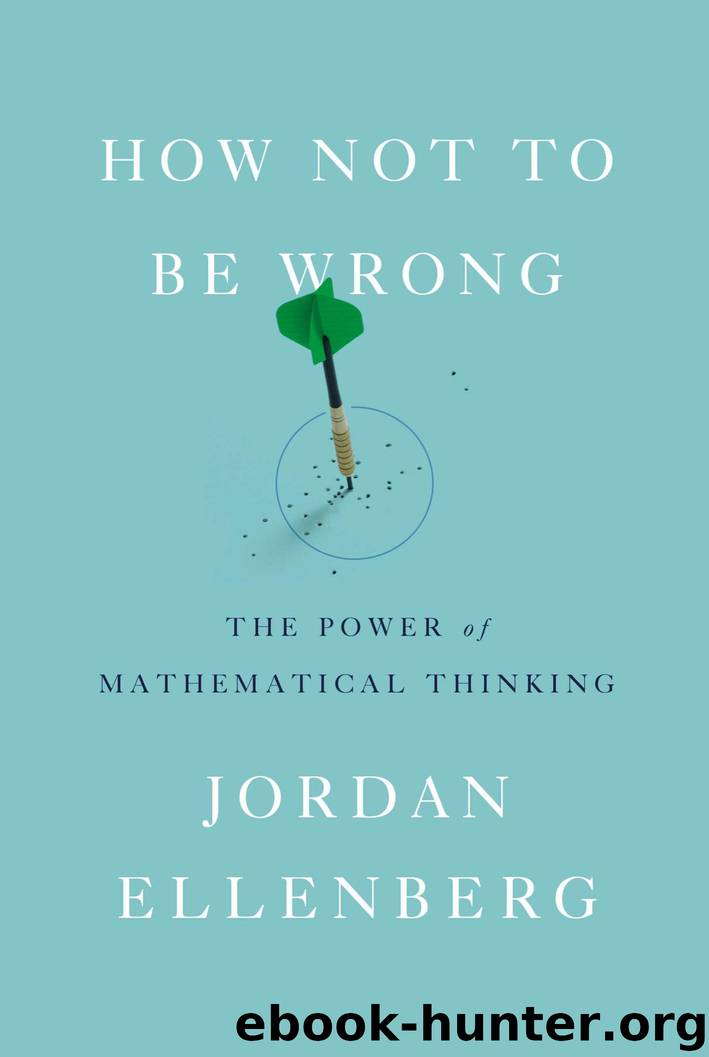How Not to Be Wrong: The Power of Mathematical Thinking by Jordan Ellenberg

Author:Jordan Ellenberg
Language: eng
Format: mobi
ISBN: 9781594205224
Publisher: Penguin Press HC, The
Published: 2014-05-28T23:00:00+00:00
WHERE THE TRAIN TRACKS MEET
Parallel lines don’t meet. That’s what makes them parallel.
But parallel lines sometimes appear to meet—think of a pair of train tracks, alone in an empty landscape, the two rails seeming to converge as your eyes follow them closer and closer to the horizon. (I find it helps to have some country music playing if you want a really vivid mental image here.) This is the phenomenon of perspective; when you try to depict the three-dimensional world on your two-dimensional field of vision, something has to give.
The people who first figured out what was going on here were the people who needed to understand both how things are and how things look, and the difference between the two: namely, painters. The moment, early in the Italian Renaissance, at which painters understood perspective was the moment visual representation changed forever, the moment when European paintings stopped looking like your kid’s drawings on the refrigerator door (if your kid mostly drew Jesus dead on the cross) and started looking like the things they were paintings of.*
How exactly Florentine artists like Filippo Brunelleschi came to develop the modern theory of perspective has occasioned a hundred quarrels among art historians, into which we won’t enter here. What we know for sure is that the breakthrough joined aesthetic concerns with new ideas from mathematics and optics. A central point was the understanding that the images we see are produced by rays of light that bounce off objects and subsequently strike our eye. This sounds obvious to a modern ear, but believe me, it wasn’t obvious then. Many of the ancient scientists, most famously Plato, argued that vision must involve a kind of fire that emanated from the eye. This view goes at least as far back as Alcmaeon of Croton, one of the Pythagorean weirdos we met in chapter 2. The eye must generate light, Alcmaeon argued: what other source could there be for the phosphene, the stars you see when you shut your eyes and press down on your eyeball? The theory of vision by reflected rays was worked out in great detail by the eleventh-century Cairene mathematician Abu ‘Ali al-Hasan ibn al-Haytham (but let’s call him Alhazen, as most Western writers do). His treatise on optics, the Kitab al-Manazir, was translated into Latin and taken up eagerly by philosophers and artists seeking a more systematic understanding of the relation between sight and the thing seen. The main point is this: a point P on your canvas represents a line in three-dimensional space. Thanks to Euclid, we know there’s a unique line containing any two specified points. In this case, the line is the one containing P and your eye. Any object in the world that lies on that line gets painted at point P.
Now imagine you’re Filippo Brunelleschi standing out on the flat prairie, the canvas on an easel in front of you, painting the train tracks.* The track consists of two rails, which we call R1 and R2. Each one of these rails, drawn on the canvas, is going to look like a line.
Download
This site does not store any files on its server. We only index and link to content provided by other sites. Please contact the content providers to delete copyright contents if any and email us, we'll remove relevant links or contents immediately.
Modelling of Convective Heat and Mass Transfer in Rotating Flows by Igor V. Shevchuk(6219)
Weapons of Math Destruction by Cathy O'Neil(5825)
Factfulness: Ten Reasons We're Wrong About the World – and Why Things Are Better Than You Think by Hans Rosling(4486)
Descartes' Error by Antonio Damasio(3163)
A Mind For Numbers: How to Excel at Math and Science (Even If You Flunked Algebra) by Barbara Oakley(3102)
Factfulness_Ten Reasons We're Wrong About the World_and Why Things Are Better Than You Think by Hans Rosling(3045)
TCP IP by Todd Lammle(3009)
Applied Predictive Modeling by Max Kuhn & Kjell Johnson(2906)
Fooled by Randomness: The Hidden Role of Chance in Life and in the Markets by Nassim Nicholas Taleb(2860)
The Tyranny of Metrics by Jerry Z. Muller(2845)
The Book of Numbers by Peter Bentley(2779)
The Great Unknown by Marcus du Sautoy(2535)
Once Upon an Algorithm by Martin Erwig(2473)
Easy Algebra Step-by-Step by Sandra Luna McCune(2466)
Lady Luck by Kristen Ashley(2409)
Practical Guide To Principal Component Methods in R (Multivariate Analysis Book 2) by Alboukadel Kassambara(2378)
Police Exams Prep 2018-2019 by Kaplan Test Prep(2354)
All Things Reconsidered by Bill Thompson III(2261)
Linear Time-Invariant Systems, Behaviors and Modules by Ulrich Oberst & Martin Scheicher & Ingrid Scheicher(2230)
